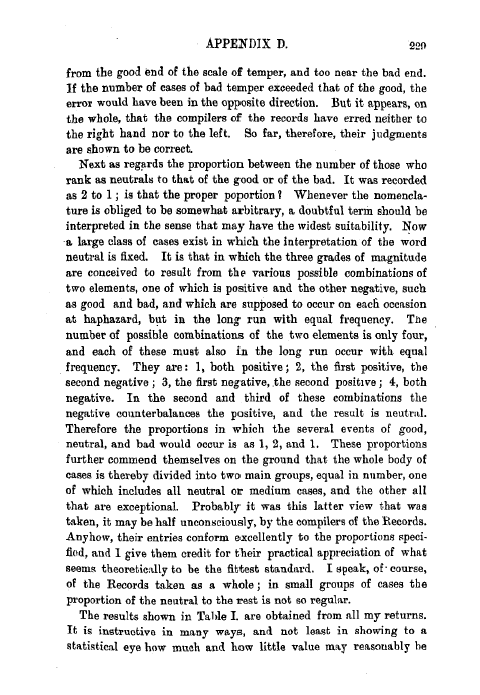APPENDIX D. 229
from the good end of the scale of temper, and too near the bad end. If the number of cases of bad temper exceeded that of the good, the error would have been in the opposite direction. But it appears, on the whole, that the compilers of the records have erred neither to the right hand nor to the left. So far, therefore, their judgments are shown to be correct.
Next as regards the proportion between the number of those who rank as neutrals to that of the good or of the bad. It was recorded as 2 to 1 ; is that the proper poportion ? Whenever the nomenclature is obliged to be somewhat arbitrary, a doubtful term should be interpreted in the sense that may have the widest suitability. Now -a large class of eases exist in which the interpretation of the word neutral is fixed. It is that in which the three grades of magnitude are conceived to result from the various possible combinations of two elements, one of which is positive and the other negative, such as good and bad, and which are supposed to occur on each occasion at haphazard, but in the long run with equal frequency. The number of possible combinations of the two elements is only four, and each of these must also in the long run occur with equal frequency. They are : 1, both positive ; 2, the first positive, the second negative ; 3, the first negative, .the second positive ; 4, both negative. In the second and third of these combinations the negative counterbalances the positive, and the result is neutral. Therefore the proportions in which the several events of good, neutral, and bad would occur is as 1, 2, and 1. These proportions further commend themselves on the ground that the whole body of cases is thereby divided into two main groups, equal in number, one of which includes all neutral or medium cases, and the other all that are exceptional. Probably it was this latter view that was taken, it may be half unconsciously, by the compilers of the Records. Anyhow, their entries conform excellently to the proportions specifiod, and I give them credit for their practical appreciation of what seems theoretically to be the fittest standard. I speak, of • course, of the Records taken as a whole ; in small groups of cases the proportion of the neutral to the rest is not so regular.
The results shown in Table I. are obtained from all my returns. It is instructive in many ways, and not least in showing to a statistical eye how much and how little value may reasonably he

